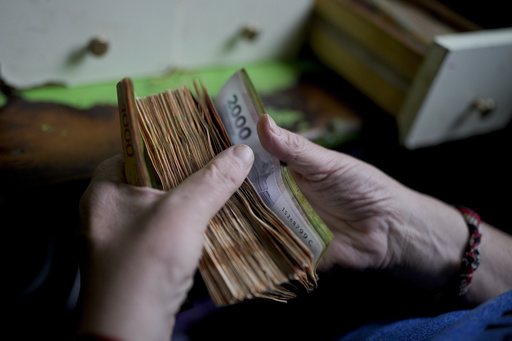WASHINGTON (AP) — The painful economic steps that Argentina’s new president, Javier Milei, announced this week sound draconian: Slashing the currency’s value in half. Reducing aid to provincial governments. Suspending public works. Cutting subsidies for gas and electricity. Raising some taxes.
Yet the South American country’s economy is such a basket case — and has been for so long — that many analysts believe that only such radical measures offer a realistic opportunity to rescue the economy.
“It was a good start,’’ said Ivan Werning, an economist at the Massachusetts Institute of Technology. “If the economy were a house, it is already burning.’’
Inflation in Argentina has hit 161%. Its economy is shrinking, in part because of a ruinous drought. In the past five years, its currency has lost about 90% of its value against the U.S. dollar. Its debts, including $45 billion that it owes the International Monetary Fund, are suffocating. One in four Argentinians lives in poverty.
Whether Milei succeeds will depend partly on details that have yet to be worked out and compromises that need to be made to win political support for his program. He commands a fragile base in the Argentine Congress, with his party ranking a distant third in the number of seats it holds.
But the critical question, economists say, is this: Will the Argentinian people – who gave Milei, a libertarian economist, nearly 56% of the vote in a runoff election last month – continue to back his plan once real economic pain inevitably sets in?
“They appear to have the sense that the population has given them a mandate to do all these painful measures,’’ said Monica de Bolle, senior fellow at the Peterson Institute for International Economics. “The moment (Argentinians) start seeing their empty pockets and nothing is really improving because it’s going to take time … people will get impatient, and that support can evaporate.’’
What makes his challenge so difficult is that Milei’s plan seems certain to make people’s lives worse long before they get better. Reduced government subsidies mean that Argentinians will pay more for electricity and transportation. A devalued peso will make imports more expensive. The annual inflation rate, de Bolle said, could roughly double to 300%.
In the meantime, the government spending cuts will derail economic growth.
“A recession next year is unavoidable,’’ said Martin Castellano, head of Latin American research at the Institute of International Finance, a banking trade group that is forecasting that Argentina’s economy will shrink 1.3% in 2024. “We think it’s going to be a painful year.’’
The economy’s troubles have been building for decades. The government, long dominated by the political descendants of the 1940s and 1950s populist strongman Juan Peron, has spent recklessly. The central bank has printed money — and fueled explosive rates of inflation — to finance the resulting debts. In the process, the Argentine peso has tumbled into freefall and lost credibility as a national currency.
The previous government sought to deny reality by strictly limiting Argentinians’ ability to exchange pesos into U.S. dollars or other foreign currencies. As a result, the official exchange rate made the peso look stronger than it actually was — around 400 pesos for every U.S. $1 before the devaluation that Milei’s government announced Tuesday. But no one was fooled. The black market has lately pegged the peso at around 1,000 per $1.
Milei is targeting what many economists see as the root of Argentina’s economic problems: Out-of-control government spending. Milei proposes to balance the budget by the end of 2024 — a bold goal — by slashing spending and imposing some tax hikes. He plans to increase aid to Argentina’s poorest to help them cushion the pain.
“Getting the fiscal house in order is mandatory, so these are the right step: a mix of taxes and spending adjustments,’’ said Werning of MIT.
The International Monetary Fund, which has repeatedly bailed out Argentina, has lent its critical support to Milei’s plan.
“These bold initial actions aim to significantly improve public finances in a manner that protects the most vulnerable in society and strengthen the foreign exchange regime,” Julie Kozack, an IMF spokeswoman, said in a statement. “Their decisive implementation will help stabilize the economy and set the basis for more sustainable and private-sector led growth.”
At the heart of Milei’s audacious economic agenda is his plan to devalue the peso from 400 to 800 per $1 U.S. dollar and then by an additional 2% each month. Part of the goal is to make Argentina’s exports less expensive — and thus more competitive — overseas and reduce the country’s gaping trade deficit.
And by making imports more expensive, the devaluation should not only help cut the trade gap but also slow the amount of money leaving Argentina. This would allow the central bank to replenish its depleted foreign-currency reserves, which are vital during financial crises.
Some economists worry that Milei’s devaluation doesn’t actually go far enough. His plan would narrow — but not close – the gap between the official exchange rate and the 1,000-peso-to-$1 rate in the black market.
“It’s like pulling the Band-Aid halfway off,’’ said Lawrence White, an economist at George Mason University and senior fellow at the libertarian Cato Institute.
Milei’s plan has also come under attack from critics on the political left who argue that it will cause needless pain to ordinary people. Juan Grabois, an activist who is close to former center-left President Cristina Fernández (2007-2015), said that Milei’s government has announced “a social murder without flinching like a psychopath about to massacre his defenseless victims.”
Milei campaigned as a radical reformer, calling himself an “anarcho-capitalist’’ and theatrically brandishing a chainsaw to illustrate his commitment to budget cutting. He would close the country’s discredited central bank, he said, and “dollarize’’ Argentina by replacing the beleaguered peso with the U.S. dollar.
Since winning, though, he has shown some tentative signs of moderation. He named a former central bank chief as his economy minister. And he appears to have shelved the dollarization plan, perhaps out of necessity.
“The truth of the matter is that Argentina could not dollarize, not right now,’’ said Liliana Rojas-Suarez, an economist who is head of the Latin America program at the Center for Global Development. “It does not have the dollars to dollarize.’’
De Bolle at the Peterson Institute said Argentina needs to scrap the existing peso, which has lost all credibility, and replace it not with dollars but with a new homegrown currency.
In 1994, she noted, Brazil vanquished two decades of hyperinflation by replacing its currency with a new one, the real.
“To this day, no hyperinflation came back,’’ she said.
For a new currency to be accepted, though, Argentinians would need to feel confident that the government was committed to controlling spending and containing inflation.
For now, many economists express at least cautious optimism that Milei is taking the right steps.
“It’s a dysfunctional economy,” Rojas-Suarez said. “Something has to be done about it. What Milei is trying to do is shock therapy. You go to the center of the problem and attack.’’
____
AP Writer Debora Rey in Buenos Aires, Argentina, contributed to this report.
Source: post





